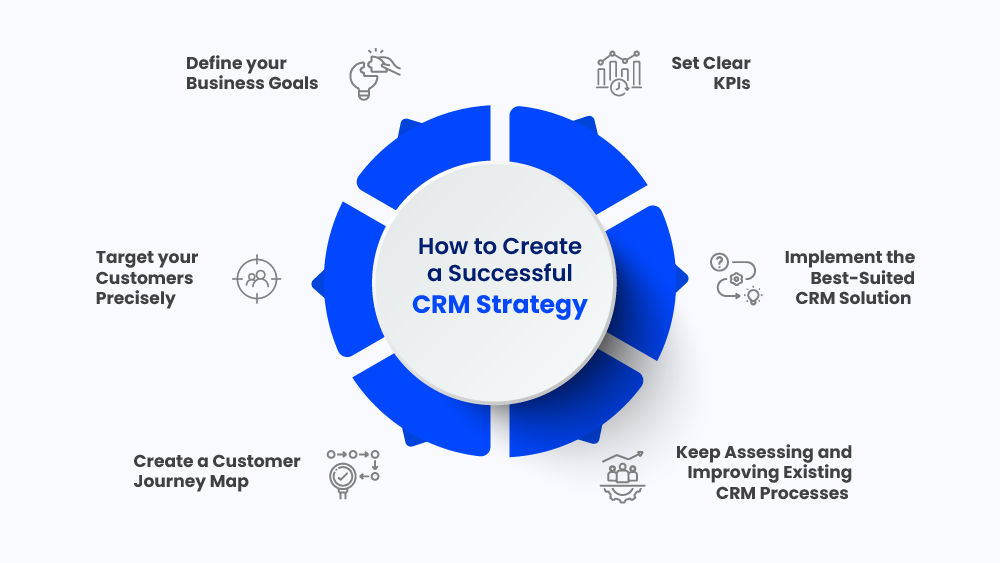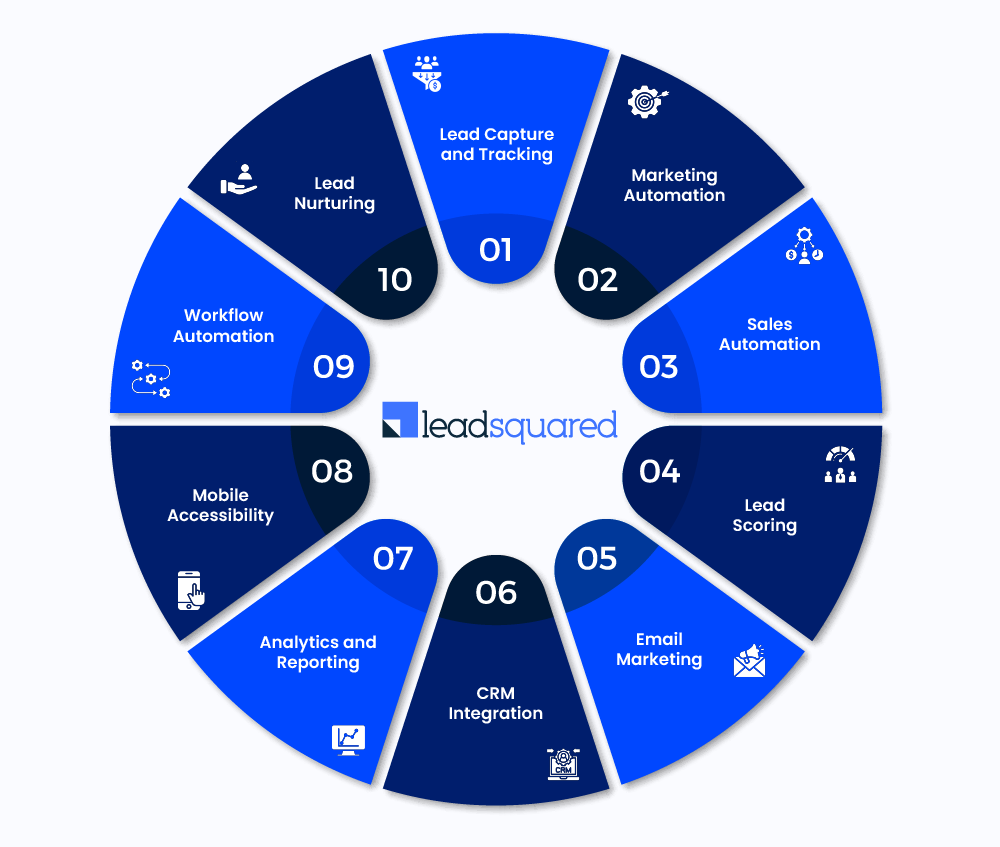Ever wondered how juggernauts like Amazon, Apple, and Airbnb effortlessly win our loyalty?
It’s no stroke of luck; it’s their finely tuned Customer Relationship Management (CRM) strategies at play.
Think about Amazon’s spot-on product recommendations, Apple’s seamless user experiences, and Airbnb’s knack for unforgettable stays.
These aren’t just flukes; they’re the results of meticulous CRM strategies in action.
In today’s interconnected world, mastering CRM isn’t a choice—it’s a business essential.
This blog is going to be your ultimate guide to navigating CRM strategy, whether you’re a business owner, a marketing professional or a digital strategist.
Let’s dive in!
What Is a CRM Strategy?
A CRM strategy is essentially your roadmap for building strong connections with customers. It involves using tools and tactics to gather insights about their preferences and behaviors.
With this knowledge, you can tailor your interactions and provide personalized experiences to them.
Ultimately, a solid CRM strategy helps businesses grow by fostering loyalty and satisfaction among their customer base.
Why Is Having a Crm Strategy Important?
A robust CRM strategy is important because it guides you through the complex landscape of customer interactions and preferences.
Specifically speaking, a CRM strategy is important for your business since it helps you to:
1. Prioritize customers with a customer-centric approach
Studies show that 86% of consumers are willing to pay more for a better customer experience.
Utilize your CRM strategy to understand customer preferences, personalize communication, and implement timely follow-ups, fostering experiences that extend beyond selling and cultivate lasting connections.
2. Leverage data-driven insights
With 73% of customers expecting companies to understand their needs, utilizing data smartly becomes pivotal.
A CRM strategy allows you to gather and leverage insights, enabling personalized interactions that resonate with your audience.
3. Enhance efficiency
Businesses using a CRM see a 25% increase in revenue. By streamlining processes and enabling better communication across departments, a CRM strategy boosts efficiency, leading to improved sales and productivity.
4. Establish Customer retention and loyalty
Acquiring a new customer can be up to 5 to 25 X more expensive than retaining an existing one. A well-executed CRM strategy focuses on nurturing existing relationships, fostering loyalty, and turning customers into brand advocates.
Now that we’ve understood what a CRM strategy is and why it is important, let’s read how you can create a successful one from scratch.
How to Create a Successful CRM Strategy

1. Define your business goals
Defining your business goals as the first step for your CRM strategy is essential to aligning customer relationship management efforts with specific objectives, ensuring a purposeful and targeted approach towards achieving organizational success.
This alignment not only helps achieve targets but also sets the groundwork for steady business growth, ensuring your efforts are purposeful and impactful.
Keep the following pointers in mind while defining your business goals:
- Identify key objectives: Determine what you aim to achieve—be it improving customer retention, increasing sales, or enhancing customer satisfaction.
- Set realistic and quantifiable goals: For instance, aiming to increase customer retention by 20% within a specific timeframe or boosting sales by a certain percentage.
- Align with customer insights: Use data to drive your goals. Analyze customer behavior patterns, feedback, and purchasing habits to inform your objectives.
- Iterate and adapt your goals: Regularly review and refine your goals based on evolving customer needs and market trends.
By aligning your CRM strategy with specific, measurable, and data-driven business objectives, you create a roadmap that not only guides your efforts but also ensures they contribute directly to your business’s growth and success.
2. Target your customers precisely
Precise customer acquisition and targeting is the second step in the process. Focusing on specific segments boosts satisfaction, drives conversions, and provides invaluable insights for smarter strategies ahead.
A thorough grasp of buyer personas, delving into demographics, behaviors, preferences, and pain points, informs personalized interactions.
Tailoring marketing efforts, communication, and product offerings ensures resonance with specific customer segments, ultimately driving enhanced engagement and satisfaction.
3. Create a customer journey map
Understanding the customer experience is pivotal in crafting a tailored CRM strategy. By delving into their journey, pain points, and desires, you can create personalized connections that drive loyalty and satisfaction.
What is a Customer Journey Map?
A customer journey map is a visual story that outlines every step a customer takes when engaging with a business. It’s like a roadmap, showing their experiences, emotions, and interactions from discovery to purchase and beyond.
Creating a customer journey map involves understanding and visualizing the various touchpoints a customer has with your business. Learn how to make a customer journey map for your business here.
4. Set clear KPIs
Setting clear CRM goals and KPIs is crucial as they act as the pulse of your business strategy, enabling precise tracking of customer-centric objectives.
These metrices not only measure success but also steer efforts towards enhanced customer relationships.
Here’s are some essential KPIs to track:
- Customer Acquisition Cost (CAC): CAC measures the cost of acquiring new customers. Lowering CAC ensures efficient spending on acquiring new leads.
- Customer Retention Rate: Customer Retention Rate tracks the percentage of customers retained over a specific period. A higher retention rate indicates better loyalty.
- Conversion rate: Conversion rate measures the percentage of leads or visitors that convert into paying customers, indicating the effectiveness of sales efforts.
- Customer Lifetime Value (CLV): CLV Predicts the total value a customer brings to your business, aiding in strategic decision-making for marketing and sales.
- Net Promoter Score (NPS): NPS gauges customer satisfaction and loyalty by asking how likely customers are to recommend your business.
- SMART criteria for goals: Ensure goals are Specific, Measurable, Achievable, Relevant, and Time-bound.
For example, “Increase customer retention by 15% within six months by implementing personalized loyalty programs.”
Implementing the most suitable CRM solution after evaluating Key Performance Indicators (KPIs) is vital for aligning the CRM strategy with business objectives.
5. Implement the best-suited CRM solution
While implementing a robust CRM strategy, choosing the right CRM solution is pivotal, and LeadSquared emerges as an ideal choice.
But, why LeadSquared?
This intuitive CRM solution acts as your smart helper, streamlining tasks, organizing data for informed decisions, and creating personalized customer experiences.
Key features of LeadSquared include:
- Lead Capture and Tracking: Efficient lead capture and tracking in LeadSquared form the foundation of a robust CRM strategy, ensuring a comprehensive view of prospect interactions and enabling targeted engagement for personalized customer experiences.
- Marketing Automation: LeadSquared’s marketing automation empowers CRM strategies by automating lead nurturing, segmentation, and campaign workflows, enabling seamless integration of mar g efforts with customer relationship management for a unified a katipo a och.
- Sales Automation: The sales automation features of LeadSquared align with CRM strategy, optimizing lead distribution, automating follow-up tasks, and providing real-time insights, enhancing the coordination between marketing and sales teams for a synchronized customer engagement approach.
- Lead Scoring: LeadSquared’s lead scoring system aligns with CRM strategies to prioritize and focus on high-value leads, facilitating a more targeted and efficient approach to customer relationship management and ensuring resources are allocated effectively.
- Email Marketing: Integrated email marketing tools in LeadSquared support CRM strategies by facilitating personalized communication, allowing businesses to nurture leads through tailored content, and maintaining a unified customer engagement strategy across channels.
- CRM Integration: Seamless integration with CRM systems ensures a centralized hub for customer data, fostering collaboration between sales and marketing teams, and promoting a holistic CRM strategy that leverages comprehensive customer insights for better decision-making.
- Analytics and Reporting: LeadSquared’s analytics and reporting features play a vital role in CRM strategies, offering valuable insights into customer behavior, campaign performance, and sales metrics, enabling data-driven decisions and continuous optimization of CRM initiatives.
- Mobile Accessibility: Mobile accessibility in LeadSquared enhances CRM strategy implementation by providing on-the-go access to critical customer data, ensuring that sales and marketing teams stay connected and responsive, contributing to an agile and customer-centric approach.
- Workflow Automation: Customized workflow automation in LeadSquared aligns with CRM strategies, streamlining processes, reducing manual effort, and ensuring consistency in lead management and customer interactions, ultimately enhancing the overall efficiency of CRM initiatives.
- Lead Nurturing: LeadSquared’s lead nurturing capabilities are integral to CRM strategies, allowing businesses to build long-term relationships with prospects by delivering relevant content and interactions, guiding leads through the customer journey for increased conversion and loyalty.

Want to do the same for your business?
The key tip to implement a successful CRM strategy doesn’t end here.
The most important and crucial step is to keep assessing, adapting and improving your processes. This ensures that you stay ahead of the game, every step of the way.
6. Keep assessing and improving existing CRM processes
Regular assessment and improvement of CRM processes are vital for adapting to changing needs, enhancing efficiency, and ensuring alignment with evolving business strategies, ultimately maximizing customer satisfaction and ROI.
Keep a check of the following pointers while going through the process of assessing CRM processes:
- Data health check: Conduct a thorough audit of stored data, ensuring accuracy and relevance, just like tidying up a cluttered workspace.
- User feedback analysis: Gather insights from teams using the CRM, understanding pain points and areas needing enhancement, similar to listening to voices from the frontline.
- Performance metrics review: Analyze CRM KPIs and metrics, identifying strengths and weaknesses, much like conducting a health check-up for business performance.
- Technology update: Explore new tools and updates, ensuring your CRM keeps pace with innovation, akin to giving your car a tune-up for optimal performance.
- Training and adoption: Provide ongoing training and support for teams, encouraging CRM adoption and maximizing its potential, like coaching for a winning team.
In Conclusion
A well-crafted CRM strategy is the backbone of business success in the digital age. From implementing the right CRM solution, like LeadSquared, to continuous assessment and improvement, each step is a strategic move toward elevating customer satisfaction and maximizing ROI.
As businesses evolve, so too must their CRM strategies – adaptable, efficient, and finely tuned to meet the demands of an ever-changing market.
Embrace the power of CRM and propel your business into a future where customer-centricity reigns supreme.
FAQs
CRM technology encompasses Operational, Analytical, and Collaborative types, serving diverse business needs through managing interactions, analyzing data, and facilitating team communication.
The key components of a CRM strategy include customer data management, personalized interactions, sales and marketing automation, customer service integration, and continuous evaluation and refinement.
Customer feedback is invaluable in shaping a CRM strategy, providing insights into preferences, pain points, and areas for improvement. Integrating feedback helps tailor experiences, enhance products/services, and foster stronger customer relationships.










